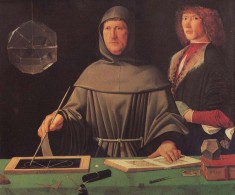| Luca Pacioli | |
|---|---|
 |
|
| Mathematician | |
| Born | 1445 |
| Died | 1517 |
| Nationality | Italian |
Luca Pacioli was a famous Italian mathematician and a seminal contributor to the accounting field. Some people refer to him as Luca di Borgo after his place of birth called Borgo Sansepolcro in Tuscany.
Early Life
Luca was born in 1445. His father was Bartolomeo Pacioli. However, Luca was not brought up in his parent’s house. As a child, he lived with the Befolci family in Sansepolcro. Although very little is known about his early life, many historians have said he received his education in the studio of della Francesca.
While still young man, he left Sansepolcro and went to Venice. In Venice, he entered the service of a wealthy merchant named Antonio Rompaisa. By this time, Luca Pacioli was well educated in basic mathematics from his studies in Sansepolcro. For this reason, he was chosen a tutor to Rompiasi’s three sons.
Educational Years
During his stay in Venice, Luca continued his mathematical studies. He studied under Domenico Bragadino. Here he gained a lot of experience in teaching from his role as a tutor. He also gained some knowledge in business from his role in helping Rompiasi’s affairs. During this time in 1470, he also wrote his very first work on arithmetic and he dedicated it to his employer’s three sons. After this, he left Venice and went to Rome where he spent the next several months.
In Rome, he lived in the home of Leona Alberti. Alberti was an excellent scholar and mathematician who provided Luca Pacioli with great religious connections. Later on, Luca studied theology and for the next few years, he became a friar in the Franciscan Order.
Contributions to Mathematics
In 1477, Luca started a life of traveling. He spent his time teaching mathematics and especially arithmetic at various universities. Between 1477 and 1480, he taught at the University of Perugia. In this university, he wrote his second work on arithmetic – This work was designed for the classes he was teaching. He also taught at Zara and wrote another book on arithmetic. None of the three arithmetic texts were ever published and only the one written for the Perugia students survived. After leaving Zara, Luca taught at the university of Perugia, then at the University of Naples and finally at University of Rome.
Summa de Arithmetica
 In 1489, after spending two years in Rome, Luca went back to his home town of Sansepolcro. Back at home, things were not pleasing to him. He was granted privileges by the Pope and this created some degree of jealousy among the religious leaders in Sansepolcro.
In 1489, after spending two years in Rome, Luca went back to his home town of Sansepolcro. Back at home, things were not pleasing to him. He was granted privileges by the Pope and this created some degree of jealousy among the religious leaders in Sansepolcro.
In 1491, he was banned from teaching. In 1493, he was invited to preach the Lent sermons. In Sansepolcro, Luca Pacioli worked on one his most popular books entitled Summa de arithmetica. He dedicated this book to the duke of Urbino called Guidobaldo. In 1494, he travelled to Venice to publish this book. This book gives a summary of the mathematics known during this time.
The book deals with algebra, arithmetic, trigonometry, and geometry. Despite its lack of originality, the book provided a basis for a major mathematical progress that took place in Europe later on after its publication. Summa also studied games of chance. Here, Luca Pacioli studied the problem of points. He gave a solution that was later proven incorrect.
Life in Milan
In 1496, Luca was invited to go to Milan to teach mathematics at Ludovico Sforza’s court. At Milan, he became good friends with Leonardo da Vinci, a court painter and engineer. They discussed mathematics and both gained a lot from the discussions. During this time, he started working on Divina Proportione.
In March of 1500, the two friends went to Venice and then later returned to Florence where they shared a house. In Florence, Luca was appointed to teach geometry at University of Pisa. He remained here until 1506. During his time in Florence, he got involved in church affairs and mathematics. He even entered the monastery of Santa Croce.
Later Life
In 1510, Luca went back to Perugia to teach again. He also lectured in Rome in 1514 but by this time, he was already old and needed to retire. He went back to Sansepolcro where he died in 1517.